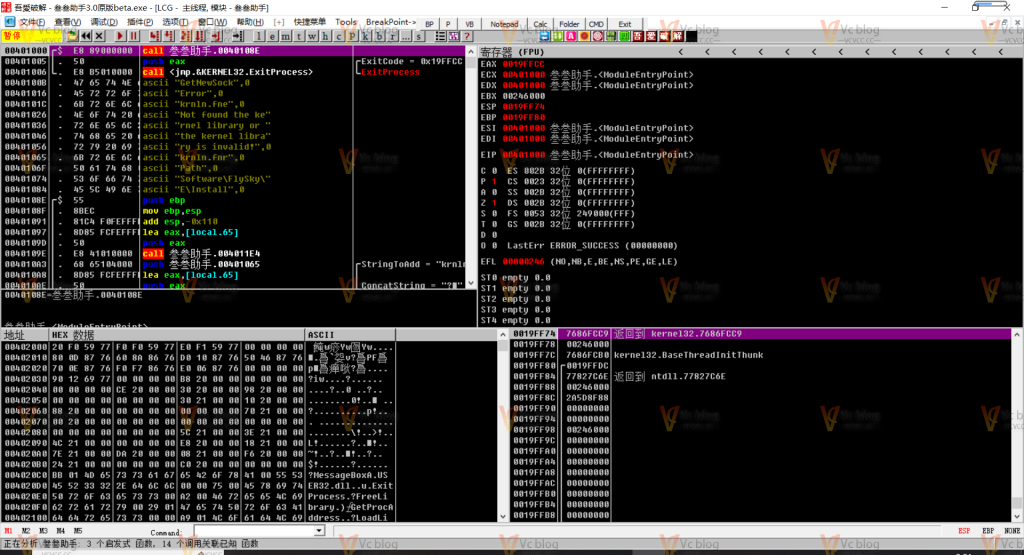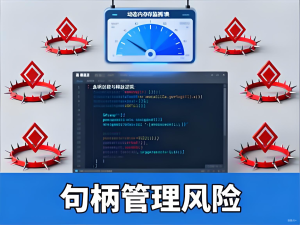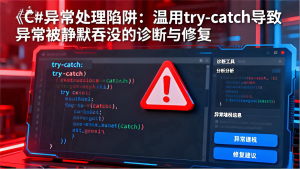本文针对C#异步编程在实际开发中的核心痛点问题,通过构建真实的高并发场景,深度分析死锁产生条件、async/await误用、资源泄漏、性能瓶颈等高频问题。提供从基础用法到高级优化的完整解决方案,涵盖任务并行库、ValueTask优化、取消令牌等实战技术。
![图片[1]-C#异步编程陷阱:从死锁规避到性能优化的完整指南](https://blogimg.vcvcc.cc/2025/11/20251109141931967-1024x576.png?imageView2/0/format/webp/q/75)
一、异步死锁问题与解决方案
1. 同步上下文导致的死锁
理解WinForms、WPF等UI线程环境中的死锁机制:
// 死锁问题重现与分析
public class AsyncDeadlockDemo
{
// 危险的异步方法 - 在UI线程中调用会导致死锁
public async Task<string> DangerousGetDataAsync()
{
// 模拟异步操作
await Task.Delay(1000).ConfigureAwait(false);
// 这里会尝试回到原始同步上下文(UI线程)
// 但如果UI线程正在同步等待这个方法,就会死锁
return "数据结果";
}
// 死锁场景演示
public void DemonstrateDeadlock()
{
// 在UI线程中同步等待异步方法 - 经典死锁模式
var result = DangerousGetDataAsync().Result;
Console.WriteLine(result);
}
// 解决方案1: 全异步化
public async Task SafeApproach1Async()
{
var result = await DangerousGetDataAsync();
Console.WriteLine(result);
}
// 解决方案2: 使用ConfigureAwait(false)
public async Task<string> SafeGetDataAsync()
{
await Task.Delay(1000).ConfigureAwait(false);
return "安全的数据结果";
}
// 解决方案3: 使用Task.Run脱离同步上下文
public async Task<string> ThreadSafeGetDataAsync()
{
return await Task.Run(async () =>
{
await Task.Delay(1000);
return "线程安全的数据";
});
}
}
// 死锁检测工具
public class DeadlockDetector
{
private readonly object _lockObject = new object();
private readonly HashSet<Task> _pendingTasks = new HashSet<Task>();
private readonly Timer _deadlockTimer;
public DeadlockDetector()
{
// 每5秒检查一次可能的死锁
_deadlockTimer = new Timer(CheckForDeadlocks, null, 5000, 5000);
}
public Task TrackTask(Task task)
{
lock (_lockObject)
{
_pendingTasks.Add(task);
}
task.ContinueWith(t =>
{
lock (_lockObject)
{
_pendingTasks.Remove(t);
}
}, TaskContinuationOptions.ExecuteSynchronously);
return task;
}
private void CheckForDeadlocks(object state)
{
lock (_lockObject)
{
var now = DateTime.Now;
var deadlockedTasks = _pendingTasks
.Where(t => t.Status == TaskStatus.WaitingForActivation ||
t.Status == TaskStatus.WaitingToRun ||
t.Status == TaskStatus.Running)
.Where(t => (now - t.CreationTime).TotalSeconds > 30) // 超过30秒认为可能死锁
.ToList();
if (deadlockedTasks.Any())
{
Console.WriteLine($"警告: 检测到 {deadlockedTasks.Count} 个可能死锁的任务");
foreach (var task in deadlockedTasks)
{
Console.WriteLine($"任务状态: {task.Status}, 创建时间: {task.CreationTime}");
}
}
}
}
}2. 异步方法中的锁竞争问题
理解异步环境下的锁机制陷阱:
// 异步锁竞争问题与解决方案
public class AsyncLockCompetition
{
// 问题代码:在异步方法中使用lock
private readonly object _syncLock = new object();
private int _sharedResource = 0;
public async Task<int> ProblematicIncrementAsync()
{
// 这会导致线程阻塞,违背异步初衷
lock (_syncLock)
{
// 在锁内执行异步操作 - 错误!
var result = await SomeAsyncOperation();
_sharedResource += result;
return _sharedResource;
}
}
// 解决方案1: 使用SemaphoreSlim
private readonly SemaphoreSlim _asyncLock = new SemaphoreSlim(1, 1);
public async Task<int> SafeIncrementAsync()
{
await _asyncLock.WaitAsync();
try
{
var result = await SomeAsyncOperation();
_sharedResource += result;
return _sharedResource;
}
finally
{
_asyncLock.Release();
}
}
// 解决方案2: 使用AsyncLock封装
public class AsyncLock : IDisposable
{
private readonly SemaphoreSlim _semaphore = new SemaphoreSlim(1, 1);
private readonly Task<IDisposable> _releaser;
public AsyncLock()
{
_releaser = Task.FromResult((IDisposable)new Releaser(this));
}
public Task<IDisposable> LockAsync()
{
var wait = _semaphore.WaitAsync();
return wait.IsCompleted ?
_releaser :
wait.ContinueWith((_, state) => (IDisposable)state!,
_releaser.Result, CancellationToken.None,
TaskContinuationOptions.ExecuteSynchronously, TaskScheduler.Default);
}
private void Release()
{
_semaphore.Release();
}
private class Releaser : IDisposable
{
private readonly AsyncLock _lock;
public Releaser(AsyncLock @lock)
{
_lock = @lock;
}
public void Dispose()
{
_lock.Release();
}
}
public void Dispose()
{
_semaphore.Dispose();
}
}
// 使用AsyncLock的示例
private readonly AsyncLock _advancedLock = new AsyncLock();
public async Task<int> AdvancedIncrementAsync()
{
using (await _advancedLock.LockAsync())
{
var result = await SomeAsyncOperation();
_sharedResource += result;
return _sharedResource;
}
}
private async Task<int> SomeAsyncOperation()
{
await Task.Delay(100);
return 1;
}
}
// 异步并发控制工具
public class AsyncConcurrencyController
{
private readonly LimitedConcurrencyLevelTaskScheduler _scheduler;
private readonly TaskFactory _taskFactory;
public AsyncConcurrencyController(int maxDegreeOfParallelism)
{
_scheduler = new LimitedConcurrencyLevelTaskScheduler(maxDegreeOfParallelism);
_taskFactory = new TaskFactory(_scheduler);
}
public Task<T> RunWithConcurrencyControl<T>(Func<Task<T>> function)
{
return _taskFactory.StartNew(function).Unwrap();
}
// 自定义任务调度器
private class LimitedConcurrencyLevelTaskScheduler : TaskScheduler
{
[ThreadStatic]
private static bool _currentThreadIsProcessingItems;
private readonly LinkedList<Task> _tasks = new LinkedList<Task>();
private readonly int _maxDegreeOfParallelism;
private int _delegatesQueuedOrRunning = 0;
public LimitedConcurrencyLevelTaskScheduler(int maxDegreeOfParallelism)
{
_maxDegreeOfParallelism = maxDegreeOfParallelism > 0 ? maxDegreeOfParallelism : Environment.ProcessorCount;
}
protected override IEnumerable<Task> GetScheduledTasks()
{
lock (_tasks)
{
return _tasks.ToArray();
}
}
protected override void QueueTask(Task task)
{
lock (_tasks)
{
_tasks.AddLast(task);
if (_delegatesQueuedOrRunning < _maxDegreeOfParallelism)
{
++_delegatesQueuedOrRunning;
NotifyThreadPoolOfPendingWork();
}
}
}
protected override bool TryExecuteTaskInline(Task task, bool taskWasPreviouslyQueued)
{
if (!_currentThreadIsProcessingItems) return false;
if (taskWasPreviouslyQueued)
{
if (TryDequeue(task))
{
return TryExecuteTask(task);
}
return false;
}
return TryExecuteTask(task);
}
private void NotifyThreadPoolOfPendingWork()
{
ThreadPool.UnsafeQueueUserWorkItem(_ =>
{
_currentThreadIsProcessingItems = true;
try
{
while (true)
{
Task item;
lock (_tasks)
{
if (_tasks.Count == 0)
{
--_delegatesQueuedOrRunning;
break;
}
item = _tasks.First!.Value;
_tasks.RemoveFirst();
}
TryExecuteTask(item);
}
}
finally
{
_currentThreadIsProcessingItems = false;
}
}, null);
}
protected override bool TryDequeue(Task task)
{
lock (_tasks)
{
return _tasks.Remove(task);
}
}
}
}二、异步资源管理与性能优化
1. IAsyncDisposable与资源清理
正确处理异步资源的生命周期:
// 异步资源管理最佳实践
public class AsyncResourceManagement
{
// 实现IAsyncDisposable的示例类
public class AsyncDatabaseConnection : IAsyncDisposable, IDisposable
{
private bool _disposed = false;
private readonly SemaphoreSlim _connectionLock = new SemaphoreSlim(1, 1);
private HttpClient? _httpClient;
public AsyncDatabaseConnection(string connectionString)
{
_httpClient = new HttpClient();
Console.WriteLine("数据库连接已创建");
}
public async Task<string> QueryAsync(string sql)
{
if (_disposed)
throw new ObjectDisposedException(nameof(AsyncDatabaseConnection));
await _connectionLock.WaitAsync();
try
{
// 模拟数据库查询
await Task.Delay(100);
return $"查询结果: {sql}";
}
finally
{
_connectionLock.Release();
}
}
// 异步释放
public async ValueTask DisposeAsync()
{
await DisposeAsyncCore();
Dispose(false);
GC.SuppressFinalize(this);
}
protected virtual async ValueTask DisposeAsyncCore()
{
if (!_disposed)
{
if (_httpClient != null)
{
_httpClient.Dispose();
_httpClient = null;
}
// 模拟异步清理
await Task.Delay(50);
Console.WriteLine("数据库连接已异步关闭");
_disposed = true;
}
}
// 同步释放
public void Dispose()
{
Dispose(true);
GC.SuppressFinalize(this);
}
protected virtual void Dispose(bool disposing)
{
if (!_disposed)
{
if (disposing)
{
_httpClient?.Dispose();
_connectionLock.Dispose();
}
_disposed = true;
}
}
~AsyncDatabaseConnection()
{
Dispose(false);
}
}
// 使用using await的示例
public static async Task DemonstrateAsyncUsing()
{
await using var connection = new AsyncDatabaseConnection("Server=...");
var result = await connection.QueryAsync("SELECT * FROM Users");
Console.WriteLine(result);
// 离开作用域时自动调用DisposeAsync
}
// 批量异步资源管理
public class AsyncResourcePool<T> : IAsyncDisposable where T : IAsyncDisposable
{
private readonly ConcurrentBag<T> _resources = new ConcurrentBag<T>();
private readonly Func<Task<T>> _factory;
private readonly int _maxSize;
private int _currentCount = 0;
private bool _disposed = false;
public AsyncResourcePool(Func<Task<T>> factory, int maxSize = 10)
{
_factory = factory;
_maxSize = maxSize;
}
public async Task<T> GetAsync()
{
if (_disposed)
throw new ObjectDisposedException(nameof(AsyncResourcePool<T>));
if (_resources.TryTake(out var resource))
{
return resource;
}
if (_currentCount < _maxSize)
{
Interlocked.Increment(ref _currentCount);
return await _factory();
}
// 等待资源可用
var tcs = new TaskCompletionSource<T>();
// 简化实现,实际中需要更复杂的等待逻辑
await Task.Delay(100);
return await _factory();
}
public void Return(T resource)
{
if (_disposed)
{
// 如果池已释放,直接释放资源
_ = DisposeResourceAsync(resource);
return;
}
_resources.Add(resource);
}
public async ValueTask DisposeAsync()
{
if (_disposed) return;
_disposed = true;
var disposalTasks = new List<Task>();
while (_resources.TryTake(out var resource))
{
disposalTasks.Add(DisposeResourceAsync(resource));
}
await Task.WhenAll(disposalTasks);
}
private async Task DisposeResourceAsync(T resource)
{
try
{
await resource.DisposeAsync();
}
catch (Exception ex)
{
Console.WriteLine($"资源释放失败: {ex.Message}");
}
}
}
}
// 异步Lazy初始化
public class AsyncLazy<T> : Lazy<Task<T>>
{
public AsyncLazy(Func<Task<T>> taskFactory)
: base(() => Task.Run(taskFactory))
{
}
public AsyncLazy(Func<T> valueFactory)
: base(() => Task.Run(valueFactory))
{
}
public TaskAwaiter<T> GetAwaiter() => Value.GetAwaiter();
}
// 使用示例
public class AsyncLazyDemo
{
private readonly AsyncLazy<HttpClient> _lazyHttpClient = new AsyncLazy<HttpClient>(() =>
{
var client = new HttpClient();
// 模拟耗时的初始化
return Task.FromResult(client);
});
public async Task<string> GetDataAsync()
{
var client = await _lazyHttpClient;
return await client.GetStringAsync("https://api.example.com/data");
}
}2. ValueTask性能优化
在热点路径中使用ValueTask减少内存分配:
// ValueTask性能优化实战
public class ValueTaskOptimization
{
// 传统Task方式 - 每次调用都会分配Task对象
public async Task<int> TraditionalAsyncMethod(int input)
{
if (input < 0)
{
throw new ArgumentException("输入不能为负数");
}
if (input == 0)
{
return 0; // 同步完成,但仍然分配Task
}
await Task.Delay(100); // 异步操作
return input * 2;
}
// 优化后的ValueTask方式
public async ValueTask<int> OptimizedAsyncMethod(int input)
{
if (input < 0)
{
throw new ArgumentException("输入不能为负数");
}
// 同步快速路径 - 不分配Task
if (input == 0)
{
return 0;
}
// 异步路径
await Task.Delay(100);
return input * 2;
}
// 缓存常用结果的ValueTask
public class CachedValueTaskProvider
{
private readonly ConcurrentDictionary<int, ValueTask<int>> _cache = new();
public ValueTask<int> GetValueAsync(int key)
{
if (_cache.TryGetValue(key, out var cachedTask))
{
return cachedTask;
}
// 创建新的ValueTask
var valueTask = ComputeValueAsync(key);
_cache.TryAdd(key, valueTask);
return valueTask;
}
private async ValueTask<int> ComputeValueAsync(int key)
{
// 模拟计算
await Task.Delay(50);
return key * key;
}
}
// IValueTaskSource自定义实现(高级用法)
public class CustomValueTaskSource<T> : IValueTaskSource<T>
{
private T? _result;
private Exception? _exception;
private ManualResetValueTaskSourceCore<T> _core;
public ValueTask<T> Task => new ValueTask<T>(this, _core.Version);
public void SetResult(T result)
{
_result = result;
_core.SetResult(result);
}
public void SetException(Exception exception)
{
_exception = exception;
_core.SetException(exception);
}
public T GetResult(short token)
{
return _core.GetResult(token);
}
public ValueTaskSourceStatus GetStatus(short token)
{
return _core.GetStatus(token);
}
public void OnCompleted(Action<object?> continuation, object? state, short token, ValueTaskSourceOnCompletedFlags flags)
{
_core.OnCompleted(continuation, state, token, flags);
}
}
}
// 异步枚举器性能优化
public class AsyncEnumerableOptimization
{
// 传统的异步枚举器
public static async IAsyncEnumerable<int> TraditionalAsyncSequence()
{
for (int i = 0; i < 100; i++)
{
await Task.Delay(10);
yield return i;
}
}
// 使用池化减少内存分配
public static async IAsyncEnumerable<int> OptimizedAsyncSequence()
{
// 使用ArrayPool减少数组分配
var buffer = ArrayPool<int>.Shared.Rent(10);
try
{
for (int i = 0; i < 100; i += 10)
{
await Task.Delay(10);
// 批量处理
for (int j = 0; j < 10 && i + j < 100; j++)
{
buffer[j] = i + j;
}
for (int j = 0; j < 10 && i + j < 100; j++)
{
yield return buffer[j];
}
}
}
finally
{
ArrayPool<int>.Shared.Return(buffer);
}
}
// 配置枚举器取消和并发
public static async IAsyncEnumerable<int> ConfiguredAsyncSequence(
[EnumeratorCancellation] CancellationToken cancellationToken = default)
{
var options = new System.Threading.Channels.BoundedChannelOptions(10)
{
FullMode = System.Threading.Channels.BoundedChannelFullMode.Wait,
SingleReader = true,
SingleWriter = true
};
var channel = System.Threading.Channels.Channel.CreateBounded<int>(options);
// 生产者任务
_ = Task.Run(async () =>
{
try
{
for (int i = 0; i < 100; i++)
{
if (cancellationToken.IsCancellationRequested)
break;
await channel.Writer.WriteAsync(i, cancellationToken);
await Task.Delay(10, cancellationToken);
}
}
finally
{
channel.Writer.Complete();
}
}, cancellationToken);
// 消费者
await foreach (var item in channel.Reader.ReadAllAsync(cancellationToken))
{
yield return item;
}
}
}三、取消令牌与超时控制
1. 取消令牌的最佳实践
正确使用CancellationToken处理取消请求:
// 取消令牌完整解决方案
public class CancellationTokenBestPractices
{
// 基础取消令牌使用
public async Task<string> ProcessWithCancellationAsync(
string data,
CancellationToken cancellationToken = default)
{
// 在方法开始时检查取消请求
cancellationToken.ThrowIfCancellationRequested();
try
{
// 模拟工作
for (int i = 0; i < 100; i++)
{
cancellationToken.ThrowIfCancellationRequested();
// 将取消令牌传递给所有异步操作
await Task.Delay(10, cancellationToken);
// 模拟CPU工作
SimulateCpuWork(i);
}
return $"处理完成: {data}";
}
catch (OperationCanceledException)
{
Console.WriteLine("操作被取消");
throw;
}
}
// 链接多个取消令牌
public async Task<string> ProcessWithLinkedTokensAsync(
string data,
TimeSpan timeout,
CancellationToken externalToken = default)
{
using var timeoutCts = new CancellationTokenSource(timeout);
using var linkedCts = CancellationTokenSource.CreateLinkedTokenSource(
externalToken, timeoutCts.Token);
try
{
return await ProcessWithCancellationAsync(data, linkedCts.Token);
}
catch (OperationCanceledException ex) when (timeoutCts.Token.IsCancellationRequested)
{
throw new TimeoutException("操作超时", ex);
}
}
// 取消令牌注册回调
public async Task<string> ProcessWithCallbacksAsync(
string data,
CancellationToken cancellationToken = default)
{
// 注册取消回调
using var registration = cancellationToken.Register(() =>
{
Console.WriteLine("取消请求已收到,正在清理资源...");
CleanupResources();
});
try
{
return await ProcessWithCancellationAsync(data, cancellationToken);
}
catch (OperationCanceledException)
{
Console.WriteLine("操作已取消完成");
throw;
}
}
// 自定义取消令牌源
public class ThrottlingCancellationTokenSource : CancellationTokenSource
{
private readonly TimeSpan _throttlePeriod;
private DateTime _lastCancellation = DateTime.MinValue;
public ThrottlingCancellationTokenSource(TimeSpan throttlePeriod)
{
_throttlePeriod = throttlePeriod;
}
public new void Cancel()
{
var now = DateTime.UtcNow;
if (now - _lastCancellation < _throttlePeriod)
{
Console.WriteLine("取消请求被限流");
return;
}
_lastCancellation = now;
base.Cancel();
}
public void Cancel(bool force)
{
if (force)
{
_lastCancellation = DateTime.MinValue;
}
Cancel();
}
}
private void SimulateCpuWork(int iteration)
{
// 模拟CPU密集型工作
for (int i = 0; i < 1000; i++)
{
_ = Math.Sqrt(i);
}
}
private void CleanupResources()
{
Console.WriteLine("清理临时资源...");
}
}
// 异步操作超时控制
public class AsyncTimeoutControl
{
// 使用Task.WhenAny实现超时
public static async Task<T> WithTimeoutAsync<T>(
Task<T> task,
TimeSpan timeout,
CancellationToken cancellationToken = default)
{
using var timeoutCts = new CancellationTokenSource();
using var linkedCts = CancellationTokenSource.CreateLinkedTokenSource(
cancellationToken, timeoutCts.Token);
var timeoutTask = Task.Delay(timeout, linkedCts.Token);
var completedTask = await Task.WhenAny(task, timeoutTask);
if (completedTask == timeoutTask)
{
throw new TimeoutException($"操作在 {timeout} 后超时");
}
timeoutCts.Cancel(); // 取消超时任务
return await task;
}
// 带默认值的超时控制
public static async Task<T?> WithTimeoutOrDefaultAsync<T>(
Task<T> task,
TimeSpan timeout,
T? defaultValue = default)
{
try
{
return await WithTimeoutAsync(task, timeout);
}
catch (TimeoutException)
{
return defaultValue;
}
}
// 可配置的重试与超时策略
public class RetryWithTimeoutPolicy
{
private readonly int _maxRetries;
private readonly TimeSpan _timeout;
private readonly TimeSpan _retryDelay;
public RetryWithTimeoutPolicy(int maxRetries, TimeSpan timeout, TimeSpan retryDelay)
{
_maxRetries = maxRetries;
_timeout = timeout;
_retryDelay = retryDelay;
}
public async Task<T> ExecuteAsync<T>(Func<CancellationToken, Task<T>> operation)
{
var exceptions = new List<Exception>();
for (int attempt = 1; attempt <= _maxRetries; attempt++)
{
try
{
using var cts = new CancellationTokenSource(_timeout);
return await operation(cts.Token);
}
catch (Exception ex) when (ex is TimeoutException or OperationCanceledException)
{
exceptions.Add(ex);
if (attempt == _maxRetries)
{
throw new AggregateException(
$"在 {_maxRetries} 次重试后操作仍失败", exceptions);
}
Console.WriteLine($"第 {attempt} 次尝试失败,{_retryDelay} 后重试...");
await Task.Delay(_retryDelay);
}
}
throw new InvalidOperationException("不应到达此处");
}
}
}四、异步异常处理与调试
1. 异步异常传播与处理
理解异步方法中的异常行为:
// 异步异常处理完整方案
public class AsyncExceptionHandling
{
// 异步异常的传播特性
public async Task DemonstrateExceptionPropagation()
{
try
{
await FaultyAsyncMethod();
}
catch (InvalidOperationException ex)
{
Console.WriteLine($"捕获到异常: {ex.Message}");
}
}
private async Task FaultyAsyncMethod()
{
await Task.Delay(100);
throw new InvalidOperationException("异步操作失败");
}
// 多个异步操作的异常处理
public async Task MultipleAsyncOperationsHandling()
{
var tasks = new[]
{
Task.Run(() => SometimesFails(1)),
Task.Run(() => SometimesFails(2)),
Task.Run(() => SometimesFails(3))
};
try
{
// 等待所有任务完成,收集所有异常
await Task.WhenAll(tasks);
}
catch (AggregateException agEx)
{
foreach (var ex in agEx.InnerExceptions)
{
Console.WriteLine($"任务异常: {ex.Message}");
}
}
catch (Exception ex)
{
Console.WriteLine($"其他异常: {ex.Message}");
}
}
// 使用WhenAll但分别处理异常
public async Task IndividualExceptionHandling()
{
var tasks = new[]
{
Task.Run(() => SometimesFails(1)),
Task.Run(() => SometimesFails(2)),
Task.Run(() => SometimesFails(3))
};
var completedTasks = new List<Task>();
foreach (var task in tasks)
{
try
{
await task;
completedTasks.Add(task);
}
catch (Exception ex)
{
Console.WriteLine($"任务失败: {ex.Message}");
// 继续处理其他任务
}
}
Console.WriteLine($"成功完成 {completedTasks.Count} 个任务");
}
private async Task SometimesFails(int id)
{
await Task.Delay(100);
if (id % 2 == 0) // 偶数ID失败
{
throw new InvalidOperationException($"任务 {id} 故意失败");
}
Console.WriteLine($"任务 {id} 完成");
}
// 异步方法中的finally块行为
public async Task FinallyBlockBehaviorAsync()
{
try
{
Console.WriteLine("try块开始");
await Task.Delay(100);
throw new Exception("测试异常");
}
finally
{
// 即使异步操作抛出异常,finally块也会执行
Console.WriteLine("finally块执行");
await CleanupAsync(); // finally块中也可以使用await
}
}
private async Task CleanupAsync()
{
await Task.Delay(50);
Console.WriteLine("清理完成");
}
// 异步栈追踪增强
public class AsyncStackTraceHelper
{
[System.Runtime.CompilerServices.AsyncMethodBuilder(typeof(AsyncTaskMethodBuilder))]
public static async Task<T> WithEnhancedStackTrace<T>(Func<Task<T>> taskFactory)
{
try
{
return await taskFactory();
}
catch (Exception ex)
{
EnhanceExceptionStackTrace(ex);
throw;
}
}
private static void EnhanceExceptionStackTrace(Exception exception)
{
// 在实际应用中,这里可以添加额外的调试信息
// 或者使用CallerMemberName、CallerFilePath等特性
Console.WriteLine($"增强异常信息: {exception}");
}
}
}
// 异步操作的状态监控
public class AsyncOperationMonitor
{
private readonly ConcurrentDictionary<string, AsyncOperationInfo> _operations = new();
public async Task<T> MonitorAsync<T>(string operationId, Func<Task<T>> operation)
{
var info = new AsyncOperationInfo
{
Id = operationId,
StartTime = DateTime.UtcNow,
Status = AsyncOperationStatus.Running
};
_operations[operationId] = info;
try
{
var result = await operation();
info.Status = AsyncOperationStatus.Completed;
info.EndTime = DateTime.UtcNow;
return result;
}
catch (Exception ex)
{
info.Status = AsyncOperationStatus.Faulted;
info.Error = ex.Message;
info.EndTime = DateTime.UtcNow;
throw;
}
finally
{
// 一段时间后自动清理完成的记录
_ = Task.Delay(TimeSpan.FromMinutes(5))
.ContinueWith(_ => _operations.TryRemove(operationId, out _));
}
}
public IReadOnlyDictionary<string, AsyncOperationInfo> GetActiveOperations()
{
return _operations.ToDictionary(kvp => kvp.Key, kvp => kvp.Value);
}
public class AsyncOperationInfo
{
public string Id { get; set; } = string.Empty;
public DateTime StartTime { get; set; }
public DateTime? EndTime { get; set; }
public AsyncOperationStatus Status { get; set; }
public string? Error { get; set; }
public TimeSpan Duration => (EndTime ?? DateTime.UtcNow) - StartTime;
}
public enum AsyncOperationStatus
{
Running,
Completed,
Faulted,
Canceled
}
}五、生产环境最佳实践
1. 异步代码质量检查清单
// 异步编程最佳实践检查工具
public static class AsyncBestPracticesChecker
{
public static void AnalyzeMethod(SyntaxTree syntaxTree, SemanticModel semanticModel)
{
var root = syntaxTree.GetRoot();
var asyncMethods = root.DescendantNodes()
.OfType<MethodDeclarationSyntax>()
.Where(m => m.Modifiers.Any(SyntaxKind.AsyncKeyword));
foreach (var method in asyncMethods)
{
CheckAsyncMethod(method, semanticModel);
}
}
private static void CheckAsyncMethod(MethodDeclarationSyntax method, SemanticModel semanticModel)
{
var issues = new List<string>();
// 检查1: 异步方法名是否以Async结尾
if (!method.Identifier.ValueText.EndsWith("Async"))
{
issues.Add("异步方法名应以'Async'结尾");
}
// 检查2: 返回类型是否为Task/Task<T>/ValueTask/ValueTask<T>
var returnType = method.ReturnType.ToString();
if (!returnType.StartsWith("Task") && !returnType.StartsWith("ValueTask"))
{
issues.Add("异步方法应返回Task或ValueTask");
}
// 检查3: 是否使用了.Result或.Wait()
var invocations = method.DescendantNodes().OfType<InvocationExpressionSyntax>();
foreach (var invocation in invocations)
{
var invocationText = invocation.ToString();
if (invocationText.Contains(".Result") || invocationText.Contains(".Wait("))
{
issues.Add("避免在异步方法中使用.Result或.Wait()");
}
}
// 检查4: 是否使用了ConfigureAwait(false)
var awaitExpressions = method.DescendantNodes().OfType<AwaitExpressionSyntax>();
bool hasConfigureAwait = awaitExpressions.Any(aw =>
aw.Expression.ToString().Contains("ConfigureAwait(false)"));
if (!hasConfigureAwait && awaitExpressions.Any())
{
issues.Add("考虑在非UI代码中使用ConfigureAwait(false)");
}
if (issues.Any())
{
Console.WriteLine($"方法 {method.Identifier.ValueText} 发现问题:");
foreach (var issue in issues)
{
Console.WriteLine($" - {issue}");
}
}
}
}
// 异步性能计数器
public class AsyncPerformanceCounter
{
private long _totalOperations;
private long _failedOperations;
private long _canceledOperations;
private readonly Stopwatch _totalTime = new Stopwatch();
public async Task<T> TrackAsync<T>(Func<Task<T>> operation, string operationName = "")
{
Interlocked.Increment(ref _totalOperations);
_totalTime.Start();
try
{
return await operation();
}
catch (OperationCanceledException)
{
Interlocked.Increment(ref _canceledOperations);
throw;
}
catch (Exception)
{
Interlocked.Increment(ref _failedOperations);
throw;
}
finally
{
_totalTime.Stop();
}
}
public AsyncPerformanceStats GetStats()
{
return new AsyncPerformanceStats
{
TotalOperations = _totalOperations,
FailedOperations = _failedOperations,
CanceledOperations = _canceledOperations,
TotalTime = _totalTime.Elapsed,
AverageTimePerOperation = _totalOperations > 0 ?
_totalTime.Elapsed / _totalOperations : TimeSpan.Zero
};
}
public record AsyncPerformanceStats
{
public long TotalOperations { get; init; }
public long FailedOperations { get; init; }
public long CanceledOperations { get; init; }
public TimeSpan TotalTime { get; init; }
public TimeSpan AverageTimePerOperation { get; init; }
public double SuccessRate => TotalOperations > 0 ?
(TotalOperations - FailedOperations - CanceledOperations) / (double)TotalOperations : 0;
}
}2. 异步架构设计模式
// 异步消息处理模式
public class AsyncMessageProcessor
{
private readonly Channel<Message> _channel;
private readonly CancellationTokenSource _cts = new();
private readonly List<Task> _workerTasks = new();
private readonly ILogger<AsyncMessageProcessor> _logger;
public AsyncMessageProcessor(int workerCount, ILogger<AsyncMessageProcessor> logger)
{
_logger = logger;
_channel = Channel.CreateUnbounded<Message>(new UnboundedChannelOptions
{
SingleReader = false,
SingleWriter = true
});
// 启动工作线程
for (int i = 0; i < workerCount; i++)
{
_workerTasks.Add(Task.Run(() => ProcessMessagesAsync(_cts.Token)));
}
}
public async Task EnqueueAsync(Message message)
{
await _channel.Writer.WriteAsync(message, _cts.Token);
}
private async Task ProcessMessagesAsync(CancellationToken cancellationToken)
{
await foreach (var message in _channel.Reader.ReadAllAsync(cancellationToken))
{
try
{
await ProcessMessageAsync(message);
}
catch (Exception ex)
{
_logger.LogError(ex, "处理消息时发生错误: {MessageId}", message.Id);
}
}
}
private async Task ProcessMessageAsync(Message message)
{
using var activity = DiagnosticSource.StartActivity("ProcessMessage", message);
// 模拟消息处理
await Task.Delay(TimeSpan.FromMilliseconds(message.ProcessingTimeMs));
_logger.LogInformation("消息 {MessageId} 处理完成", message.Id);
}
public async Task StopAsync()
{
_channel.Writer.Complete();
_cts.Cancel();
await Task.WhenAll(_workerTasks);
}
}
public record Message(string Id, int ProcessingTimeMs);
// 异步限流器
public class AsyncRateLimiter
{
private readonly SemaphoreSlim _semaphore;
private readonly TimeSpan _timeWindow;
private readonly int _maxRequests;
private DateTime _windowStart;
private int _requestCount;
public AsyncRateLimiter(int maxRequests, TimeSpan timeWindow)
{
_semaphore = new SemaphoreSlim(1, 1);
_maxRequests = maxRequests;
_timeWindow = timeWindow;
_windowStart = DateTime.UtcNow;
_requestCount = 0;
}
public async Task<T> ExecuteAsync<T>(Func<Task<T>> operation)
{
await WaitForSlotAsync();
try
{
return await operation();
}
finally
{
Interlocked.Increment(ref _requestCount);
}
}
private async Task WaitForSlotAsync()
{
while (true)
{
await _semaphore.WaitAsync();
try
{
var now = DateTime.UtcNow;
if (now - _windowStart >= _timeWindow)
{
// 时间窗口重置
_windowStart = now;
_requestCount = 0;
}
if (_requestCount < _maxRequests)
{
return; // 有可用的槽位
}
// 计算需要等待的时间
var waitTime = _windowStart + _timeWindow - now;
if (waitTime > TimeSpan.Zero)
{
await Task.Delay(waitTime);
}
}
finally
{
_semaphore.Release();
}
}
}
}总结
C#异步编程的核心在于理解任务调度、同步上下文和资源生命周期管理:
关键问题总结:
- 🔒 死锁风险:同步上下文中的阻塞等待导致死锁
- 🚀 性能瓶颈:不必要的任务分配和上下文切换
- 🗑️ 资源泄漏:未正确实现IAsyncDisposable
- ⏱️ 取消困难:未正确传递CancellationToken
- 🐛 调试复杂:异步栈追踪信息丢失
解决方案优先级:
- 使用ConfigureAwait(false)避免不必要的上下文切换
- 实现IAsyncDisposable正确管理异步资源
- 使用ValueTask减少热点路径的内存分配
- 正确传递CancellationToken支持取消操作
- 使用Channel等高级结构处理数据流
最佳实践检查清单:
- ✅ 异步方法名以Async结尾
- ✅ 返回Task/Task<T>/ValueTask/ValueTask<T>
- ✅ 在库代码中使用ConfigureAwait(false)
- ✅ 正确实现IAsyncDisposable接口
- ✅ 及时传递CancellationToken参数
- ✅ 避免在异步方法中使用.Result和.Wait()
- ✅ 使用Channel等生产级异步数据结构
- ✅ 实现适当的重试和超时策略
通过系统化地应用这些最佳实践,可以构建出高性能、可维护且健壮的C#异步应用程序。
© 版权声明
THE END

















暂无评论内容